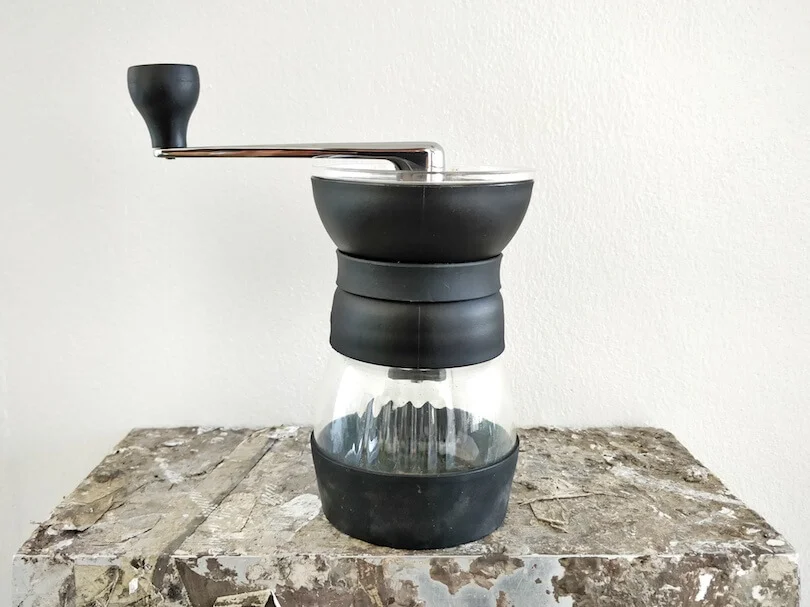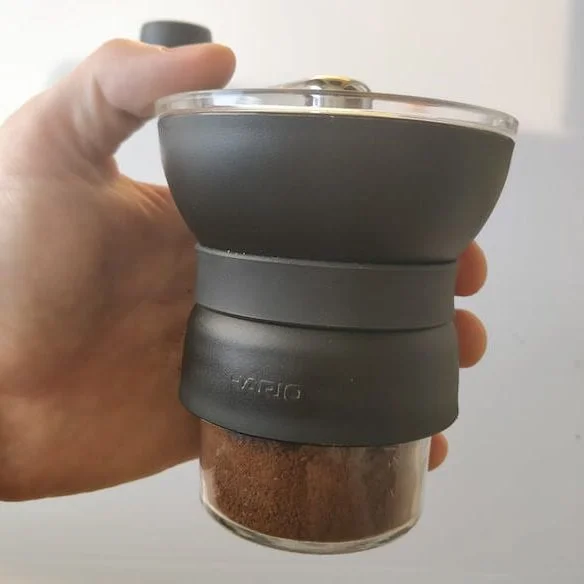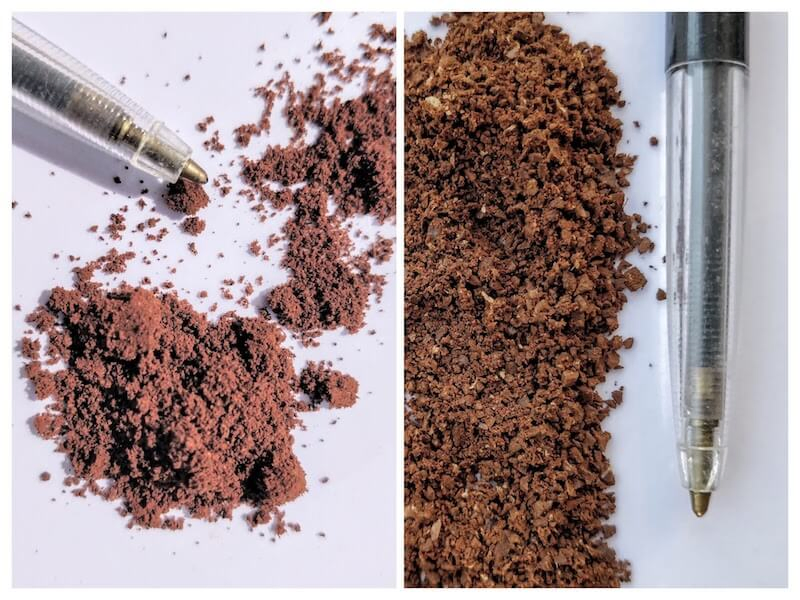HARIO SKERTON PRO REVIEW
According to this reviewer, it is capable of grinding Espresso fine sizes.
I tried the finest and tested it on unpressurized basket in CM-14, using 15 g. It looked powdery, good for Turkish brewing. In the CM-14 I did around 10 times of the double shot to get 30 g. It was oily but tasted good. Not sour or bitter. The second 30 g is watery.
You may start by looking at the cleaning of this grinder.

HARIO SKERTON PRO REVIEW
The new and updated Hario Skerton Pro is a proper entry level manual grinder. Find out, whether you should consider it right here,
The Hario Skerton is one of the most iconic hand grinders out there.
A few years back, Hario released a new and improved version of it: The so-called Hario Skerton ‘Pro’.
At the time it was released, the Skerton Pro was actually a decent budget option.
However, today there are just some way better options available in this cost range.
I recently did a video over on YouTube about, why I don’t recommend the Skerton Pro anymore. Check it out, if you want the full explanation.
ABOUT HARIO AND THEIR GRINDERS
Hario is a Japanese company that is famous all over the world for their coffee equipment. The brand’s most well-known product, of course, is the Hario V60 pour over cone, but the kettles, range servers, and grinders are also popular among specialty coffee consumers.
Hario combines minimalist and cute Japanese aesthetics with quality, usability and a good price. The company produces several grinders by now, and you could say that the new Skerton Pro fits somewhere in the upper middle of their range.
WHY YOU SHOULD CONSIDER A HAND GRINDER
But before we get into the meat of this review let’s just talk briefly about manual grinders. Why even bother with grinding your beans in the hand, when you have plenty of electric models that are more than proficient out there? Well, I will give you my reasons.
Usually, electric grinders are way more expensive than manual grinders. When you buy an electric version, most of the price tag covers the motor and the housing. The burrs usually aren’t anything spectacular. That means in raw grinding capability, you get a lot bang for your buck when purchasing a hand grinder.

Another great reason to consider a manual grinder is that it’s way easier to bring with you when you go camping or go on holidays. Having a grinder and a nice little brewer, such as the Aeropress, with you, really makes your trip so much more fun. Trust me on this one!
So even though you might want to use an electric grinder on a daily basis – after all it’s way easier to just press a button – you should consider the hand crank grinder just for the sake of travel.
HARIO SKERTON PRO GRINDER REVIEW
The first thing you notice, when you get the new 2017 model in your hand is how premium and nicely designed it is. My girlfriend even proclaimed that it was ‘sooo cute’, which is an honor normally only reserved for cats on Youtube.
Actually, the grinder in itself is quite simple and it consists of 4 main parts:
- You have a grounds bin that’s protected by a silicone layer that also acts as non-slip stabilizer mat if you want to place it on a table while grinding.
- Then you have the combined hopper and burr unit, where you fill in the beans.
- On top of that, you have a nicely curved plastic lid that fits perfectly.
- And lastly, you have the new and improved metal crank. This handle is built to last!
FEELS PREMIUM
Hario has done a magnificent job here. All parts fit perfectly together and feel very solid. Besides the glass grounds bin, it’s hard to see any of these parts break from normal use. It’s also worth mentioning that a normal mason jar will fit as a grounds bin, so should you have an accident, it’s not really the end of the world.
Especially the metal crank and the curved plastic lid are nice upgrades to the ones used in the original Skerton.

EASE OF USE
As expected from a somewhat low tech tool, it is a hand grinder that’s entirely simple to utilize: Pour in the beans in the top, get the biceps to work, and after a minute or two you have freshly ground coffee!
Compared to the earlier generation of the Skerton, this model features some significant improvements when it comes to usability.
- Before the lid was made out of silicone and you sort of had to massage it into place. The new lid has this very nice, curvy design, so it almost locks into place immediately.
- The crank handle has also been updated. Now it locks in place by being put on an Allen wrench.
For me, it’s no problem holding the grinder in one hand and turning the handle with the other. However, if you have really small hands it might be more comfortable in the long run with a slimmer grinder.
IMPROVED GRIND ADJUSTMENT
Adjusting the grind setting of the old Hario Skerton was complicated. You had to take off the lid and a special locking ring, and then turn a knob. Not only was this overly complicated, but because you didn’t get any tactile feedback it was way harder to navigate the settings.
What the new Skerton Pro has done is to borrow the system from another Hario model – the Hario Slim Mini Mill.
This means that you can now adjust the grind setting underneath the burrs, by turning a small ring that gives you a small ‘click’ for every increment. This makes it a lot faster and easier to adjust the coarseness, when you wanna go from, say, espresso to pour over.
HOW FAST DOES IT GRIND?
The Hario Skerton Pro does a very decent job when it comes to speed.
I usually use 26,5 grams of coffee to 400 grams of water for my daily pour over coffee and the grinder was able to grind that on a medium-fine setting in 1 minute and 22 seconds (see the picture below).
(Update 2020: For comparison the 1Zpresso Jx grinds the same amount of coffee in approximately 35 seconds. So by modern standards the Skerton Pro is rather slow.)
This grinder definitely grinds fine enough for espresso. Just be prepared for some work. It takes me around 2 minutes to grind 14 grams of ultra fine espresso grounds.
I tested the grinder next to its little brother, the Hario Slim and the OE Lido 3, and as expected it was somewhere in between these two. The Lido 3 was faster, but not as much as you might think.
GRIND CONSISTENCY

On the left: Ultra fine for espresso. Right: A medium-fine grind for Aeropress or pour over.
As you can see from the picture the grind consistency is decent, although not perfect. For everyday use, it’s okay, however.
Fines sometimes get a bad rep, but actually, a little amount doesn’t really affect the brew that much. I have found that I have been able to brew on devices such as the Hario V60 and Clever Dripper without any issues with over-extraction or a clogged filter.
Compared to the old Skerton the grind for French Press is also a lot more uniform. The new design of the housing means that the burrs wobble less on the coarser spectrum.
I was surprised that the Skerton grinds so well for espresso. At its finest, it actually grinds too fine, so it will clog the portafilter if you don’t find the right setting.
It’s possible to use the Skerton Pro for travel with this little hack: The grounds bin of has the exact same diameter as a mason jar, so you can easily find a smaller one made of plastic.
With a small plastic jar, this grinder is only a total of 265 grams, while the Hario Slim is 245 grams. For those 20 grams extra, you get a grinder that is a lot faster and smaller height-wise.
ALTERNATIVES?
A few years ago there weren’t many good hand mills in this price range.
Nowadays, however, you have options from 1zPresso and Timemore that simply blow the Hario grinder out of the water.
For that reason, I suggest that you extend your budget just a tiny bit and go for one of those models with real ball bearings and steel burrs instead. In day to day use, it’s just so much nicer.
THE FINAL VERDICT
The Hario Skerton Pro offers decent grinding, nice build quality, and a bubbly design at a budget price.
But today this design paradigm is kinda outdated, and for that reason I don’t recommend the Hario Skerton Pro anymore.
It’s a nice piece of coffee history, but unfortunately nothing more than that.
See more user reviews right here.
ASSER CHRISTENSEN
Hello, and welcome! I'm the editor & founder of this site.
I have been a coffee geek since I started home roasting more than a decade ago. Since then, coffee has taken me on countless adventures: From ancient coffee ceremonies in Ethiopia to the volcanos of Sumatra.
My background is in journalism, and today I'm also a licensed Q Grader under the Coffee Quality Institute.

Comments
Post a Comment